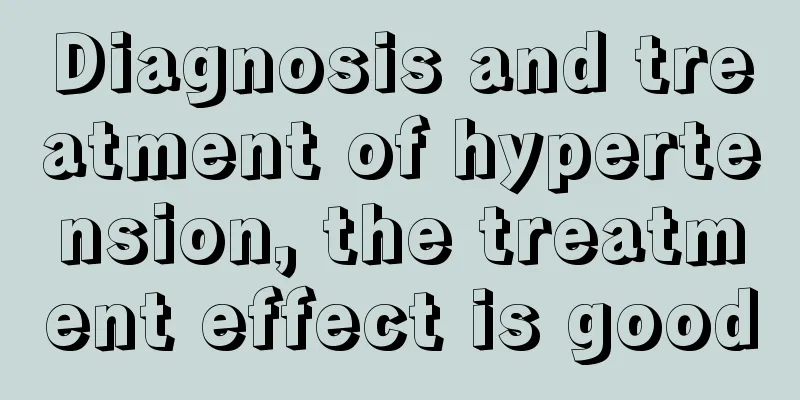Diagnosis and treatment of hypertension, the treatment effect is good

|
Hypertension is a common disease, and most elderly people suffer from varying degrees of hypertension. The treatment of hypertension generally relies on some antihypertensive drugs. Only special cases of hypertension will be treated with surgery or other treatments to lower blood pressure. 1. Differential diagnosis Secondary hypertension should be differentiated when hypertension is first diagnosed. Common causes of secondary hypertension include kidney disease, renal artery stenosis, primary aldosteronism, and hypertension caused by pheochromocytoma. Most secondary hypertension can be improved through treatment of the primary disease or surgery. II. Treatment 1. Treatment of essential hypertension 1. Treatment objectives and principles The main goal of hypertension treatment is to achieve blood pressure control, and the ultimate goal of antihypertensive treatment is to minimize the incidence and mortality of cardiovascular and cerebrovascular diseases in patients with hypertension. Antihypertensive treatment should establish blood pressure control target values. On the other hand, hypertension often coexists with other risk factors for cardiovascular and cerebrovascular diseases, such as hypercholesterolemia, obesity, diabetes, etc., which synergistically increase the risk of cardiovascular disease. Treatment measures should be comprehensive. The blood pressure lowering targets are different for different populations. The general blood pressure lowering target for patients is below 140/90 mmHg. For high-risk patients with comorbidities such as diabetes or kidney disease, the blood pressure should be lowered as appropriate. For all patients, regardless of whether their blood pressure is higher than normal at other times, attention should be paid to monitoring their blood pressure in the morning. Studies have shown that more than half of the patients whose blood pressure meets the standard in the clinic do not meet the standard in the morning. (1) Improve lifestyle behaviors ①Reduce and control weight. ②Reduce sodium intake. ③Supplement calcium and potassium salts. ④Reduce fat intake. ⑤Increase exercise. ⑥Quit smoking and limit drinking. ⑦ Reduce mental stress and maintain psychological balance. (2) Individualization of blood pressure control standards Due to different causes and different pathogenesis of hypertension, clinical medication should be treated differently and the most appropriate drug and dosage should be selected to obtain the best therapeutic effect. (3) Coordinated control of multiple cardiovascular risk factors: Although blood pressure is controlled within the normal range after antihypertensive treatment, multiple risk factors other than elevated blood pressure still have an important impact on prognosis. 2. Antihypertensive drug treatment For patients with detected hypertension, recommended antihypertensive drugs for initial and maintenance treatment should be used, especially drugs that can control blood pressure for 24 hours and achieve target blood pressure when taken once a day. Specifically, four principles should be followed, namely, starting with a small dose, giving priority to long-acting preparations, combination therapy and individualization. (1) Types of antihypertensive drugs ① Diuretics. ②β-receptor blockers. ③Calcium channel blockers. ④Angiotensin-converting enzyme inhibitors. ⑤Angiotensin II receptor blockers. The choice of single drug or combination therapy should be based on the patient's risk factors, target organ damage, and concurrent clinical diseases. The principles for selecting antihypertensive drugs are as follows: 1) Use blood pressure medications with a half-life of 24 hours or more, taken once a day, that can control blood pressure for 24 hours, such as amlodipine, to avoid iatrogenic poor control of early morning blood pressure due to inappropriate treatment options; 2) Use safe, long-term medications that can control blood pressure every 24 hours to improve patient compliance with treatment; 3) Use drugs that have sufficient clinical trial evidence of cardiovascular and cerebrovascular benefits and can truly reduce long-term cardiovascular and cerebrovascular events, reduce cardiovascular and cerebrovascular events, and improve the quality of life of patients with hypertension. (2) Treatment plan: Most patients without complications or comorbidities can use thiazide diuretics, beta-blockers, etc. alone or in combination. Treatment should start with a low dose and increase gradually. In actual clinical use, the patient's cardiovascular risk factors, target organ damage, complications, comorbidities, antihypertensive efficacy, adverse reactions, etc. will all affect the choice of antihypertensive drugs. Patients with stage 2 hypertension can be treated with a combination of two antihypertensive drugs from the beginning. 2. Treatment of secondary hypertension It is mainly aimed at treating the primary disease. For example, for hypertension caused by pheochromocytoma, blood pressure can be reduced to normal after tumor resection; renal vascular hypertension can be treated by interventional therapy to dilate the renal artery. For patients whose primary disease cannot be cured surgically or whose blood pressure remains high after surgery, in addition to other treatments targeting the cause, appropriate antihypertensive drugs should be used for antihypertensive treatment. |
<<: What are the precautions for sinus tachycardia
>>: What are the symptoms of uremia
Recommend
Is subarachnoid hemorrhage fatal?
Subarachnoid hemorrhage is a common neurological ...
The occurrence of cervical cancer may also be related to fungal infection
The occurrence of cervical cancer may also be rel...
These seven parts of the human body can never be cleaned no matter how hard you wash them
Most people have never thought about whether thei...
How to guide introverted children
Different people have different growing environme...
Self-heating lunch box principle
Self-heating lunch boxes are very convenient to u...
Can early laryngeal cancer be completely cured?
After laryngeal cancer occurs, the harm to the pa...
Patients with advanced gastric cancer should focus on replenishing qi in their diet
Patients with advanced gastric cancer will show s...
How to treat gonorrhea? 5 important points to note
In today's era of sexual openness, gonorrhea ...
Is invasive hydatidiform mole a malignant hydatidiform mole?
Invasive hydatidiform mole is a malignant hydatid...
Postoperative care measures for breast cancer patients
Surgical resection is one of the key measures for...
What to do if you get diarrhea after drinking cold water
Diarrhea is one of the most common diseases in li...
Why does smoking cause lung cancer
Smoking can easily lead to lung cancer, mainly be...
Contraindications and precautions for radiotherapy of lung cancer
Radiotherapy for lung cancer is a method of treat...
The hazards of several common colon cancers
Don’t mistakenly think that the occurrence of col...
What should be paid attention to during the treatment of lung cancer? These issues should be paid attention to when treating lung cancer
Lung cancer is a disease that causes serious harm...









